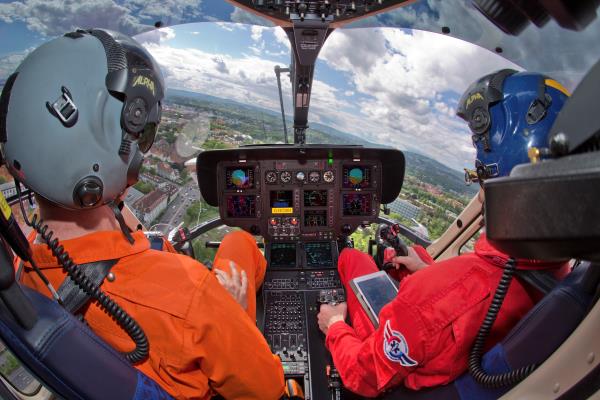Partners in the SESAR demonstration project, PBN Rotorcraft Operations under Demonstration (PROuD), presented the results of two years’ work at a recent workshop in Rome. The project successfully demonstrated how satellite-based take-off and landing procedures can enhance helicopter operations for critical emergency services.
PROuD is one of the several large-scale demonstration activities co-funded by the SESAR Joint Undertaking (SJU), the public-private partnership that pools the knowledge and resources of the entire European air traffic management community to deliver innovative solutions for a modernised ATM.
The project aimed at demonstrating how performance-based navigation (PBN) satellite-based approach and departures, low-level instrument flight route (IFR) route procedures, can enhance helicopter operations for critical emergency services, such as search and rescue and transporting medical patients. PBN flight procedures are pre-defined routes that pilots can follow even in lower visibility conditions, using guidance provided by on-board instruments.
To test the new procedures and routes, a total of 88 flight trials were performed by helicopter emergency medical service (HEMS) teams at four sites: Samedan and Chur (Switzerland), Lørenskog and Ullevål (Norway). In Norway, approximately 10% of emergency missions (around 700 flights each year) cannot be flown due to bad weather, while in Switzerland about 600 emergency medical missions have to be aborted each year due to poor visibility. With the introduction of enhanced navigational instruments, pilots are able to fly precise approaches in poor weather conditions leading to improved success rates of emergency missions.
The data gathered in the flight trials was used to evaluate the impact of new PBN procedures on selected key performance areas such as safety, accessibility, availability and human performance, and to demonstrate operational benefits for HEMS operators coming from the implementation of the PBN flight procedures in PROuD scenarios.
Specifically, the Swiss trial campaign provided important evidence to support the approval by the Swiss Federal Office of Civil Aviation (FOCA) of the use of IFR procedures by helicopters in class G uncontrolled airspace. Unlike Norway, where IFR procedures have been approved by the regulator, Swiss pilots can currently only fly visual flight rules (VFR). In the case of Samedan airport, the project developed the first ever helicopter Required Navigation Performance (RNP) approach procedure with Authorization Required (AR) with RNP 0.1 NM in conjunction with the use of Radius to Fix (RF) legs, reaching a significantly lower minimum compared to a PinS (Point-in-Space) RNP approach to LPV (Localizer Performance with Vertical guidance) minimum.
Meanwhile, the PinS RNP approach and PinS departure procedures flown in the Norwegian scenarios (Lørenskog and Ullevål heliport areas) were approved for operational use by Norsk Luftambulanse (NLA) by the Norwegian certification authorities, who attended the flight trials. The PinS departure procedure was also validated and temporarily approved for NLA operations.
 PROuD results demonstrate that the introduction of the new PBN operational solutions improve safety, especially in low visibility conditions and during night operations. Also both the possibility to take off and land (in terms of reduction of landing minima, number of diversions and missed approaches) are improved. New PBN procedures can definitely enhance HEMS availability and continuity, especially under adverse meteorological conditions.
PROuD results demonstrate that the introduction of the new PBN operational solutions improve safety, especially in low visibility conditions and during night operations. Also both the possibility to take off and land (in terms of reduction of landing minima, number of diversions and missed approaches) are improved. New PBN procedures can definitely enhance HEMS availability and continuity, especially under adverse meteorological conditions.
The project outcomes will steer and promote the adoption of these kinds of solutions all over Europe. Already the project results has been endorsed EHA (European Helicopter Association) and EHAC (European HEMS & Air Ambulance Committee), which have provided guidance and feedback and a supporting interface with European regulators.
PROuD brings together NLA (Norsk Luftambulanse) the Swiss air rescue (Rega), IDS (responsible for the design of the procedures), Skyguide (the Swiss Air Navigation Services Provider) and Deep Blue (collecting data demonstrating the expected benefits). The helicopter used for the test flights is the Agusta Westland AW109SP, already certified for RNP 0.3 and RNP APCH operations and equipped with ADS-B out capability for the demonstration trials.
Offering advanced air traffic services
 The solutions demonstrated by PROuD are part of a broader set of solutions (key feature) aimed at advancing air taffic services, in line with the vision of the European ATM Master Plan.
The solutions demonstrated by PROuD are part of a broader set of solutions (key feature) aimed at advancing air taffic services, in line with the vision of the European ATM Master Plan.
View other solutions within this key feature
